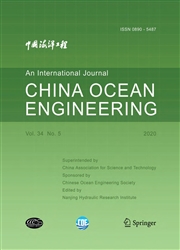A RANS-VoF Numerical Model to Analyze the Output Power of An OWC-WEC Equipped with Wells and Impulse Turbines in A Hypothetical Sea-State
作者:Paulo R*F*Teixeira,Rafael A*A*C*Gonçalves,Eric Didier
摘要:Wave energy is a renewable source with significant amount in relation to the global demand. A good concept of a device applied to extract this type of energy is the onshore oscillating water column wave energy converter(OWC-WEC). This study shows a numerical analysis of the diameter determination of two types of turbines, Wells and Impulse, installed in an onshore OWC device subjected to a hypothetical sea state. Commercial software FLUENT?,which is based on RANS-VoF(Reynolds-Averaged Navier-Stokes equations and Volume of Fluid technique), is employed. A methodology that imposes air pressure on the chamber, considering the air compressibility effect, is used. The mathematical domain consists of a 10 m deep flume with a 10 m long and 10 m wide OWC chamber at its end(geometry is similar to that of the Pico's plant installed in Azores islands, Portugal). On the top of the chamber, a turbine works with air exhalation and inhalation induced by the water free surface which oscillates due to the incident wave. The hypothetical sea state, represented by a group of regular waves with periods from 6 to 12 s and heights from 1.00 to 2.00 m(each wave with an occurrence frequency), is considered to show the potential of the presented methodology. Maximum efficiency(relation between the average output and incident wave powers) of46% was obtained by using a Wells turbine with the diameter of 2.25 m, whereas the efficiency was 44% by an Impulse turbine with the diameter of 1.70 m.
发文机构:Engineering School Harbours and Maritime Structures Division
关键词:waveenergyoscillatingwatercolumnWellsturbineImpulseturbineRANS-VoFcompressibleair
分类号: O35[理学—流体力学]
- Hydrodynamic Study on Energy Capturing Performance of Horizontal Axis Blades Under Sub-Low Speed Tidal Current
- Structural Model Updating of Jacket Platform by Control Theory Using Vibration Measurement Approach
- Study on the Overload and Dwell-Fatigue Property of Titanium Alloy in Manned Deep Submersible
- Modal Parameters Identification of A Real Offshore Platform From the Response Excited by Natural Ice Loading
- MPS Method for Interaction Between Solitary Waves and Submerged Horizontal Plate
- Influence Analysis and Vibration Restraint Solutions Research on the Underwater Acoustic Monitoring System
- Fully Coupled Simulation of Interactions Among Waves, Permeable Breakwaters and Seabeds Based on N−S Equations
- Extreme Wave Simulation with Iterative Adaptive Approach in Numerical Wave Flume
- Experimental Investigation of Disturbing the Flow Field on the Vortex-Induced Vibration of Deepwater Riser Fitted with Gas Jetting Active Vibration Suppression Device
- Fluid Mud Measurement and Siltation Analysis in A Trial Excavated Channel in the Approach Channel of the Xiangshan Port


